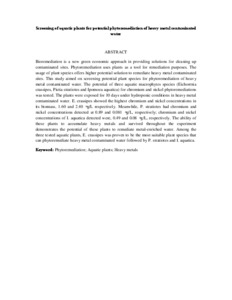Citation
Wan Mohd Musdek, Wan Noraina Atikah and Sabullah, Mohd Khalizan and Juri, Nor Mustaiqazah and Abu Bakar, Norliza and Shaharuddin, Noor Azmi
(2015)
Screening of aquatic plants for potential phytoremediation of heavy metal contaminated water.
Bioremediation Science & Technology Research, 3 (1).
pp. 6-10.
ISSN 2289-5892
Abstract
Bioremediation is a new green economic approach in providing solutions for cleaning up contaminated sites. Phytoremediation uses plants as a tool for remediation purposes. The usage of plant species offers higher potential solution to remediate heavy metal contaminated sites. This study aimed on screening potential plant species for phytoremediation of heavy metal contaminated water. The potential of three aquatic macrophytes species (Eichorrnia crassipes, Pistia stratiotes and Ipomoea aquatica) for chromium and nickel phytoremediations was tested. The plants were exposed for 10 days under hydroponic conditions in heavy metal contaminated water. E. crassipes showed the highest chromium and nickel concentrations in its biomass, 1.60 and 2.40 μg/L respectively. Meanwhile, P. stratiotes had chromium and nickel concentrations detected at 0.89 and 0.081 μg/L, respectively; chromium and nickel concentrations of I. aquatica detected were, 0.49 and 0.08 μg/L, respectively. The ability of these plants to accumulate heavy metals and survived throughout the experiment demonstrates the potential of these plants to remediate metal-enriched water. Among the three tested aquatic plants, E. crassipes was proven to be the most suitable plant species that can phytoremediate heavy metal contaminated water followed by P. stratiotes and I. aquatica.
Download File
![[img]](http://psasir.upm.edu.my/64036/1.hassmallThumbnailVersion/Screening%20of%20aquatic%20plants%20for%20potential%20phytoremediation%20of%20heavy%20metal%20contaminated%20water.pdf)  Preview |
|
Text (Abstract)
Screening of aquatic plants for potential phytoremediation of heavy metal contaminated water.pdf
Download (49kB)
| Preview
|
|
Additional Metadata
Actions (login required)
 |
View Item |

